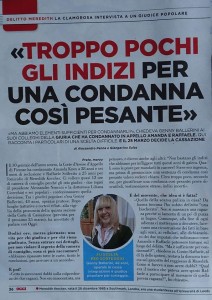
Italian journalist Remo Croci recently spoke out providing a scathing critique denouncing the case against Amanda Knox and Raffaele Sollecito. A juror has expressed doubt in the guilty verdicts, and the Italian media has raised legitimate concerns.
The Italian Supreme Court is set to rule once again on the case against Amanda Knox and Raffaele Sollecito. The two currently stand convicted of the 2007 murder of Meredith Kercher in a hilltop cottage in Perugia, Italy. The case, fraught with controversy, has seen Knox and Sollecito convicted, exonerated, and then convicted again. All while a third defendant, Rudy Guede, has been tried and convicted in a separate “fast track” trial that resulted in a 16-year sentence when finalized by the high court.
Several news stories have surfaced in Italy that are favorable to the defense as another major ruling draws near. The Italian Supreme Court is expected to render a decision on Wednesday on the most recent appellate court ruling that reinstated the guilty verdicts for Knox and Sollecito. The court has the option of finalizing the convictions, sending the case back for another appeal, or annulling the verdicts outright.
Italian Journalist Remo Croci has voiced his opinions over the past few days on social media and Italian television. Croci reports for LaNuova Riviera and his bio lists him as a senior editor of News Mediaset. He took investigators and judges to task on Facebook, stating that they should be removed “For the errors and horrors committed in this case.”
 Croci’s comments focus on Raffaele Sollecito. Croci issued an apology to Sollecito, stating: “For the first time since following murder cases I feel the obligation to apologize to one of the accused. In this specific case I’m referring to Raffaele Sollecito. In November of 2007 I followed the Meredith Kercher murder case through the news program TG5 and from the first days I developed the conviction that the young man and then student from Puglia was involved in the crime. My conviction came exclusively from the information that was being provided by the investigators. It was a castle of accusations that seemed insurmountable. My error was to believe all the information that those investigators provided to me. I didn’t have the counterproof of the evidence.”
Croci’s comments focus on Raffaele Sollecito. Croci issued an apology to Sollecito, stating: “For the first time since following murder cases I feel the obligation to apologize to one of the accused. In this specific case I’m referring to Raffaele Sollecito. In November of 2007 I followed the Meredith Kercher murder case through the news program TG5 and from the first days I developed the conviction that the young man and then student from Puglia was involved in the crime. My conviction came exclusively from the information that was being provided by the investigators. It was a castle of accusations that seemed insurmountable. My error was to believe all the information that those investigators provided to me. I didn’t have the counterproof of the evidence.”
Croci then calls out Prosceutor Giuliano Mignini for manipulating the media early on. Croci recalls that Mignini informed the press that Amanda Knox, while waiting to be questioned, confided to Meredith Kercher’s friends that Kercher had been killed by having her throat slit. Mignini boldly asked the press “how could she know that if she hadn’t seen the body?” According to Mignini, this was proof that Knox committed the murder. Croci would later find out that Mignini’s statements were false when he heard medical personnel at the first hearing state that they had told Knox and Sollecito how Kercher was killed. According to Croci, that is when he “started to understand that they had recounted to us a heap of manipulated facts of which many more were to follow.”
Croci concludes by lambasting investigators for mishandling evidence. “The contamination of the bra clasp is the tip of the iceberg. After 46 days during which everybody and everything entered that room, how could that clasp not be contaminated? And those videos aired by the Scientific Police of the late discovery of the clasp? It would be making of comedy film if it hadn’t been a dramatic case about Meredith. How could I believe that public officials could stoop so low?”
Croci appeared on Italian television this week reiterating his thoughts about the case. Croci spoke on Vera TV on a program called “La Signora in Giallo” with Giangavino Sulas, a journalist for Oggi magazine. Both Croci and Sulas think there is a strong chance that Sollecito will be sent back for a new appeal, while Knox gets convicted. They do not base their opinions on logic, but rather the recent change in perception in Italy. Both believe the two are innocent.

Sollecito’s defense team put a strategy in place after the guilty verdicts were reinstated in order to give their client what they believed was the best chance for freedom. Sollecito’s attorneys have essentially used blunders of the Florence appellate court to open the door to an alternative solution. Sollecito has proof that he was home on the evening of the murder based on computer activity. The court (wrongly) concluded that Knox went out on the night of the murder based on cell phone records. This provided Sollecito’s defense the opportunity to show separation of the two defendants, at least in the eyes of the court.
Sollecito’s defense offers the Italian Supreme Court an alternative option in their appeal of the verdict against their client: “if you still want to believe the “evidence” that was used to convict, at least consider that specifically against Sollecito there’s nothing, since he was for sure at home until 9:26 and there is none of his DNA on what you call the murder weapon. Therefore, if you have to convict –if you still want to believe that there is his footprint in the bathroom, that his DNA is found on the hook of a bra– convict him only for “favoreggiamento”, for helping with the cleaning after the crime.”
The appellate court’s conclusions are deeply flawed. According to the court, Knox went out that evening since her text to her boss Patrick Lumumba was said to come from the cell tower that serves the area near the cottage at 8:35 pm. The cell tower information was later shown to be inaccurate. A witness also demolished the theory. Sollecito’s friend, Jovana Popovic, testified that she was greeted at the door of Sollecito’s apartment at 8:40 pm by Knox. This would not have been possible if Knox was out near the cottage just five minutes prior. But these facts did not seem important to the Florence court.
Sollecito’s attorneys do not claim to agree with the conclusions of the appellate court. In fact, Sollecito’s defense team has strongly defended Knox over the past seven years. The defense is simply telling the court that they cannot have it both ways. Either the two were together or they were apart. It appears their strategy to help their client may be working, at least with the Italian public.
A wildly popular Italian television program “Porta a Porta” aired a special on March 12 that was extremely favorable to the defense. DNA pioneer Peter Gill was a guest on the show. Gill heavily criticized evidence collection (see video) and the Italian experts agreed with his assessment. Once again, the focus from the Italian commentators was almost solely on Sollecito’s innocence. Interestingly, the show was missing the usual pro-guilt panel to argue the points raised. The show appeared to be intentionally making a statement by focusing on the message of innocence.

In another turn of events, OGGI magazine reported last week that juror Genny Ballerini from the Florence appeal has come forward expressing doubts about the trial. Ballerini now believes she may have made a mistake agreeing to the guilty verdict, telling OGGI that the prosecution’s case contained “questionable proof, flimsy evidence and bizarre testimony.” Ballerini went on to say that the two did not get a fair trial because there was “an atmosphere of guilt” in the deliberation room before the trial even started.
A source in Italy told me that it is unusual to see this wave of positive coverage shortly before the high court is expected to sign off on the convictions. It is anyone’s guess if the flurry of news reports casting doubt over the convictions are a sign of how the high court will rule.
If the high court bases their conclusions solely on merits of the Florence appeal, finalizing the convictions will not be an option. Sollecito’s defense team recently filed an appeal supplement to the court highlighting egregious errors in the appellate ruling. The supplement highlights fourteen key reasons why the high court should not confirm the lower court’s decision.
The report is over 300 pages so I will only briefly detail a few of the points here. Shockingly, the court creates evidence in its motivation out of thin air. The appeal court ruling alleges that there were three bloody footprints in the murder room, presumably belonging to a woman. These alleged footprints are considered proof of the presence of multiple attackers. These footprints do not exist. They are not mentioned by any of the experts that analyzed the case, and have appeared in no court documents.
The court misrepresents testimony of the police officer that retrieved the alleged murder weapon from Raffaele Sollecito’s kitchen drawer. The court relied on the claim by police officer Finzi that he chose the knife among others in the same drawer because of his own “investigative intuition” that the knife appeared to be particularly bright and clean.
Defense analysis of Finzi’s testimony at trial shows that he first tried to say that the knife looked compatible with the victim’s wounds. After cross-examination, he admitted that he knew nothing about the wounds, so he changed his story, claiming that he used investigative intuition. The truth is that there was no logical reason to single out that knife. The knife was later found to be incompatible with the wounds, leading the court to make the baseless claim that a second smaller knife was used by Sollecito in the attack. There is no evidence to suggest multiple knives. All of the wounds are compatible with a smaller blade. The court completely ignores the fact that two switchblades confiscated from Sollecito tested negative for the victim’s DNA. The fact is that the wounds were inflicted using a small knife, not a large kitchen knife, and Sollecito’s small blades were tested and ruled out as possible murder weapons.
The court places far too much weight on mixed DNA samples of Knox and Kercher collected from their small shared bathroom. The samples are easily justified by the frequent shared use of that bathroom by the two. Crime scene video footage also shows inappropriate evidence collection techniques that would have triggered mixing. The investigator in the video wipes large surface areas with the same collection swab, mixing visible blood with any residual DNA that was on the bathroom surfaces from normal daily use.
Citing a matter of law, Raffaele’s defense states that the Florence court violated article 192 section 3 of the Italain Penal Procedural Code by giving credibility to Rudy Guede’s statements given at his own trial. According to the law, the Judge has to verify the general reliability of the defendant or convicted criminal accusing other defendants and to find external validations to his testimony. The defense states that the unreliability of Guede was established during his trials and no external validations were provided.
Guede’s trial played a crucial role in the case being sent back to the appellate level in the first place. This case exposed a major flaw in the Italian justice system. The reasoning behind the Italian Supreme Court (ISC) decision to overturn the acquittals of Knox and Sollecito was based on the ruling in Guede’s trial. Guede opted for a Fast-Track trial, separate from Knox and Sollecito. Guede’s story changed like the wind as he worked to give himself the best opportunity for leniency. After seeing Knox in news reports before his arrest, Guede initially claimed in a recorded skype conversation with a friend that Knox was not present at the crime scene. He would later change his tune, as he crafted his storyline to match the necessary theory needed to please the court and lessen his own punishment. When it was all said and done, the Guede trial court concluded that multiple attackers committed the crime, naming Knox and Sollecito as perpetrators. This ruling was signed off on by the ISC without stipulation when they finalized Guede’s verdict.
Therefore, the multiple attacker scenario, including Knox and Sollecito, became a judicial truth in the eyes of the ISC. For this very reason, Knox and Sollecito’s acquittals were annulled, sending their case back to trial, along with specific instructions laid out by the ISC directing the Florence appeals court to convict.
The problem is that Knox and Sollecito had absolutely no representation at Guede’s trial. They were convicted in the eyes of the ISC in a trial that they were not part of. With their decision, the ISC stripped Knox and Sollecito of their rights to a fair trial granted to them by Italian law.
The same high court that wronged Knox and Sollecito is now set to rule on their case once again. It needs to be noted that the Italian Supreme Court varies greatly from the U.S. Supreme Court. Italy’s high court is composed of more than 350 judges, meaning that Knox and Sollecito do have a chance of receiving a reasonable ruling from a completely new panel of judges.
Based on the court’s prior actions, some supporters for Knox and Sollecito are fearing the worst. Dr. Mark Waterbury, author of “The Monster of Perugia – The Framing of Amanda Knox,” recently spoke to the Daily Mail, stating: “It’s my understanding that people who are working with the family believe that the ruling will come from facts based on the ‘judicial truth’ from Rudy’s trial where they said there must have been multiple attackers. This fact can’t be contested.” Waterbury goes on to say: “This is like someone down your street being tried for a crime, but they decide to convict you afterwards because that person claimed you were involved and you can’t even defend yourself. It makes no sense and just wouldn’t happen in the UK or US. It is truly astounding. One more round to go in this crazy justice system. I don’t have a good feeling about this.”
Nigel Scott is a staunch advocate for Knox and Sollecito in the UK that writes for Spiked.com. Scott published an article today titled: “When will they stop hounding Amanda Knox?“. In the article he writes: “Going on past behaviour, the Italian Supreme Court (ISC) will likely confirm the latest guilty verdicts on the pair that were handed down by Judge Alessandro Nencini in Florence last year. This will not mean that the case is over, merely that it acquires a wider dimension as it moves to Strasbourg and the European Court of Human Rights.”
The support from Italy appears to be more optimistic. Frank Sfarzo, an Italian writer that has written in support of Knox and Sollecito over the past seven years, told the Daily Mail that he believes there is an 80 percent chance that Knox and Sollecito will see their convictions overturned.
Sfarzo went on to say that he believes Knox and her supporters in Seattle should look at how opinions have changed in Italy in recent months on the case.
Regardless of Wednesday’s outcome, this case does not appear to be reaching a resolution anytime soon. If the case is sent back for another appeal, it could continue to drag on for years to come. If the convictions are confirmed, the case will head to the European Court of Human Rights. Given the latter scenario, an extradition battle could eventually come into play.
I recently spoke with Michael Scadron, a former lawyer for the US Department of Justice, about the possibility of extradition. Scadron told me that he feels confidant the Knox/Sollecito case will not get that far, stating: “This is anything but your typical case, not only because it is high profile and controversial, but it is laden with due process and human rights issues. The courts generally don’t second guess the State Dept. on such matters (this is referred to as the “Rule of Non Inquiry”), but the State Dept. has unfettered discretion to consider such issues as fairness, improper (i.e. political) motivation behind a foreign conviction, and human rights concerns. If State rejects a request to extradite, it never reaches the courts.”
Support for Knox and Sollecito can be seen worldwide. A team of world-class experts in law enforcement, DNA, and forensics have reviewed this case and concluded that Amanda Knox and Raffaele Sollecito are both innocent. The two are victims of a bungled investigation that could have easily been corrected early on if the authorities would have simply admitted that they had made a mistake. Instead, in an attempt to save face, they pushed forward to condemn two innocent people. A disturbing trail of disastrous police work, and reports of egregious misconduct would soon follow. Some key examples include; improper evidence collection, suppression of lab data, cover-up of contamination, and the failure to test a possible semen stain found at the crime scene where a sexual assault had taken place.
Our organisation Injustice in Perugia has created a petition on Change.org directed to the Italian Ministry of Justice and the appropriate UK and US government offices requesting them to investigate the activities of the Perugian law enforcement authorities and the 2007 consular staffs following the Meredith Kercher murder. You can view the petition here.
Many eyes will be on Italy tomorrow. Will the Italian Supreme Court correct the errors of the past or will they sign off on one of the greatest injustices in modern history?
 Wrongful Conviction News an Injustice anywhere website
Wrongful Conviction News an Injustice anywhere website
